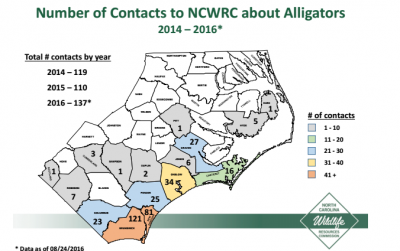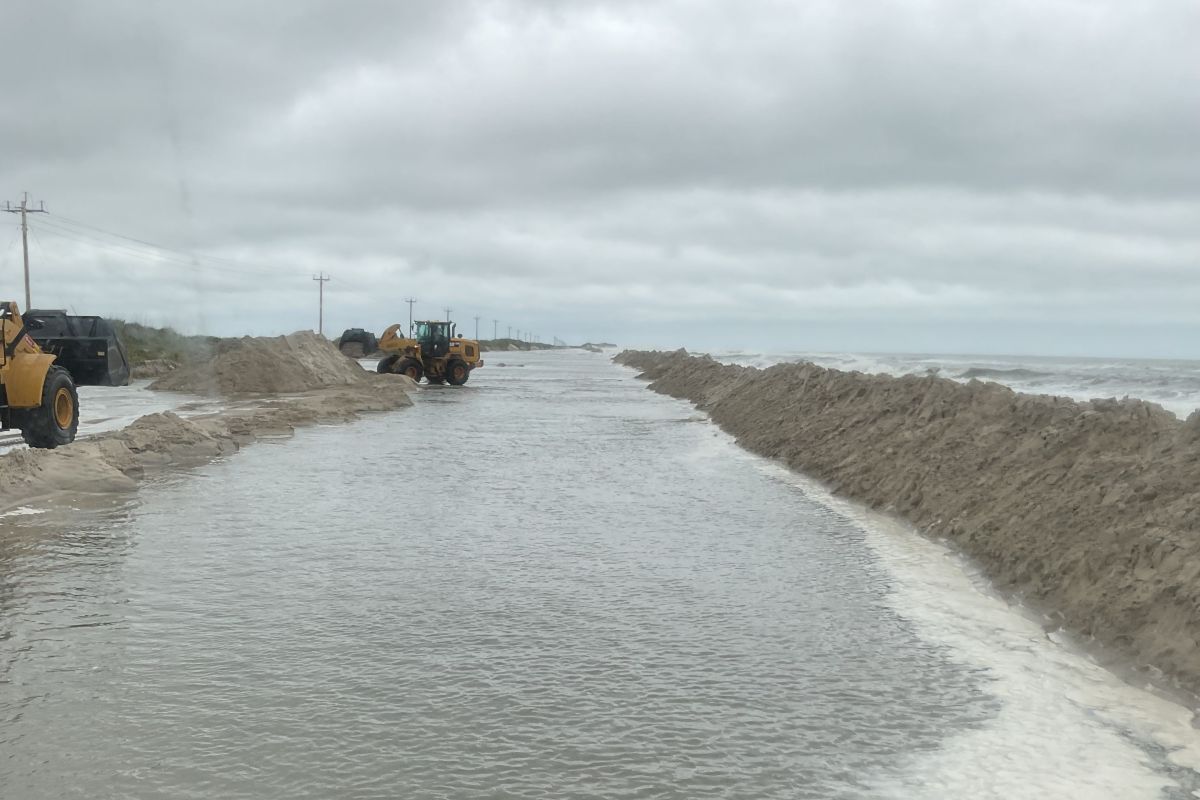SWANSBORO – Are alligators a public safety menace or a misunderstood creature that deserves protection?
A divided crowd of about 30 people showed up last week to voice their opinions and thoughts about an alligator management plan the North Carolina Wildlife Resources Commission is drafting. The meeting, which was held Wednesday at the Swansboro Recreation Center, was one of three public forums hosted by the commission to gather public comments before the plan’s completion. The other two sessions were in Leland earlier in the week and in Manteo on Thursday.
Supporter Spotlight

Gordon Myers, the commission’s executive director, appointed the 15-member North Carolina Alligator Task Force, which is set to release a draft of the management plan next spring. The task force is made up of scientists, North Carolina residents and commission staff. Myers said that the public comments collected would be considered in the final plan.
“Tonight’s forum is part of the process of developing the alligator management plan,” he said to the crowd. “It’s very important that the public participate.”
The task force was assembled after the commission received public comments, including many from conservation groups, opposed to a proposal to allow alligator hunting. The commission, in a resolution, asked the task force to develop a management plan that includes characteristics of alligators, identifies knowledge gaps and lays out the public’s opinions on alligators and their management. Additionally, the plan will include recommendations for management strategies in areas with alligator overpopulation and recommendations of management areas.
The American alligator, which finds its northernmost range in North Carolina, was once listed as an endangered species. Because of measures enacted to protect it, alligator populations bounced back. However, the alligator is still listed as endangered based on its similarity in appearance and range to the American crocodile, which is extremely rare.
People who attended the meeting were asked about their knowledge of alligator biology, their opinions on the proposed alligator management methods and where they see over-population. Most of the questions were multiple choice, and the audience used electronic clickers to submit their answers.
Supporter Spotlight
When asked why they chose to attend the forum and voice their opinion, members of the audience were split: 35 percent said alligator conservation was their main concern while 42 percent said public safety was of utmost importance.
One woman said she worried about the safety of children in camps in the region where she lives.

“We live in Pamlico County and there are several camps – sailing camps, swimming camps – where we are, and now we’re seeing quite a few alligators,” she said, “and that’s one of the reasons we’re here, because we’re fighting for these children.”
Another man asked whether someone would have to be hurt, or possibly killed, by an alligator before officials address their presence.
“What does it take in public waters … before something is done about the alligators?” he said. “Is it kind of like intersections out here on the roads, several people have to get killed?”
The man later said alligators should be removed.
Others said they supported efforts to stabilize populations, rather than reduce their numbers. Robbie Withington, a wildlife biologist at the Marine Corps Air Station New River, said in an interview after the forum that alligators play a specific role in the local ecosystem.
“For so many years and they’ve been here and the other populations have basically kind of stabilized around them,” Withington said. “If you decrease alligators, someone else (another species) is going to increase.”
Withington said alligators are misunderstood. He said that in the last 25 years North Carolina has only seen three incidents of injuries related to alligators, but no deaths.
“They’re not historically a big issue. They’re not, like, aggressive,” he said.
Mary Ann Ryan of Havelock said in an interview after the forum that she attended the meeting because she loves learning about animals and educating others about them. She said alligators are harmless if left alone and that the public should do more to learn about them.
“The information is out there,” she said. “You can go right to the wildlife website. You can read everything about the alligator: that not to be afraid of them, don’t feed them, don’t go stick your hand in their mouth.”

Also during the meeting, Mike Campbell, an outreach specialist at the commission, discussed so-called “nuisance” alligators. He said what is considered a nuisance is relative based on the person that finds them. For some people, he said, just the sight of an alligator is considered a nuisance.
“They see an alligator, they’re afraid. Something’s got to be done with it,” he said.
From the agency’s perspective, however, Campbell said nuisance alligators are primarily ones that have lost their fear of humans. He said this is because alligators have learned to associate people with a handout.
“They’re almost always alligators that have been fed,” he said. “They’re just habituated to people.”
Alligators that escape their natural habitats and wander onto roads or other public places, those that cause property damage and those who have shown the ability to be a threat to humans, pets or livestock are also considered nuisances.
Fifty-two percent of respondents at the forum said education is the best way to prevent the illegal feeding of alligators. Ryan echoed the sentiment, noting that many negative alligator incidents are the result of feeding the alligators.
“I think we definitely need to educate the public,” she said, “because in Pamlico County, where they’re talking about the alligator problem there, deer poachers throw their carcasses in the water, fisherman throw their trash in the water. What are they doing? They’re feeding alligators.”
While attendees were divided on most topics discussed, one question elicited a unified response. When asked if alligator hunting would support the species’ conservation, 79 percent of attendees said “yes.” Allen Boynton, Wildlife Diversity Program coordinator at the commission, said some populations of endangered animals, including bears, have been brought back through the support of hunters.

“Bear hunters are some of the strongest advocates for bear conservation in the state,” he said.
Members of the audience nodded in agreement.
Hunting, however, isn’t a one-size-fits-all solution. In North Carolina, cooler weather causes slower population growth rates in alligators compared to southern populations due to a later age of sexual maturity. In the alligator hunting resolution, the commission states that “these variable life history traits make alligators in North Carolina more vulnerable to over-harvest.” However, the resolution also states that alligators have a “patchy” distribution throughout the state, and that there is a public interest in allowing hunting in areas where populations are sustainable or overabundant.
Task force member Alvin Braswell, emeritus research curator of the North Carolina Museum of Natural Sciences, said the task force would continue to seek public participation in the management plan. He said individuals and organizations are encouraged to comment on the draft plan when it is released next spring.
“Everybody deserves to be heard,” he said.







